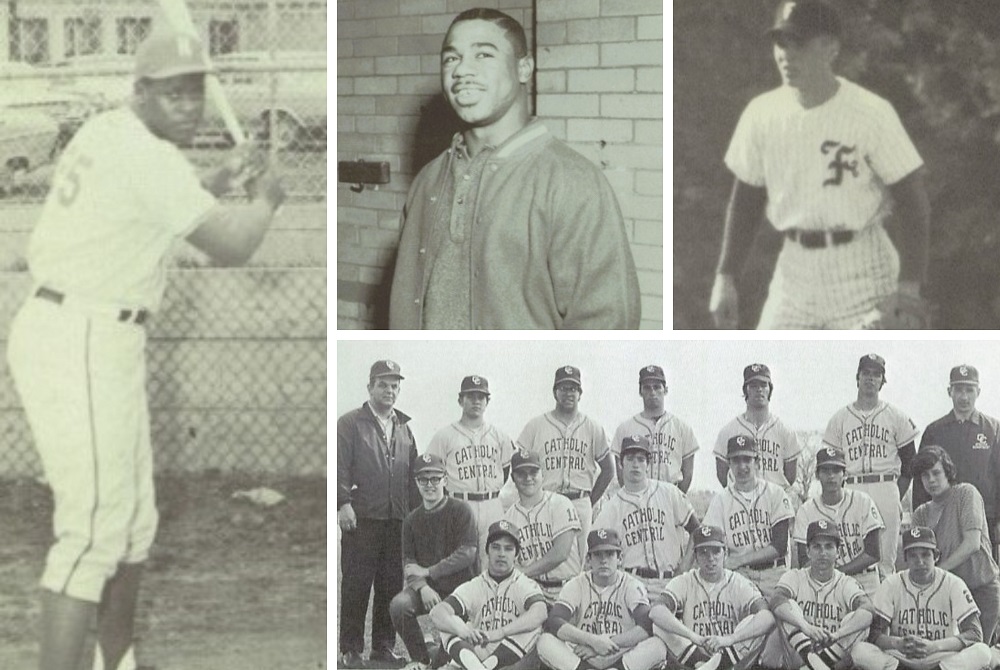
Over MLB Draft's History, Michigan High Schools Graduate 25 1st-Round Picks
By
Ron Pesch
MHSAA historian
May 6, 2022
Long before today’s travel ball captivated the scene, recreation sandlot baseball programs – often sponsored by local businesses and guided by volunteer coaches – sparked the dreams of countless kids, instilling a love of the game and a hope they might, one day, grace a bubble-gum card.
Hundreds of thousands of prep ballgames have been played since Major League Baseball instituted the amateur draft in 1965. Since that time, 25 Michigan high school ballplayers have been chosen in the first round of the league’s annual draft. Without a doubt, Derek Jeter, who played for Kalamazoo Central and spent 20 seasons with the New York Yankees, stands as the most accomplished. Bloomfield Hills Brother Rice’s Nick Plummer is the most recent to join the list. Selected by St. Louis in 2015, the outfielder spent seven seasons in the minors before making his debut this spring with the New York Mets. He is the 13th on the list to see time in the Majors.
The Draft
“Prior to the implementation of the First-Year Player Draft, amateurs were free to sign with any Major League team that offered them a contract,” notes the Baseball Almanac detailing the process’s history. “As a result, wealthier teams such as the New York Yankees and St. Louis Cardinals were able to stockpile young talent, while poorer clubs were left to sign less desirable prospects.
“Originally, three separate drafts were held each year. The June draft, which was by far the largest, involved new high school graduates, as well as college seniors who had just finished their seasons. … A second draft was held in January for high school and college players who graduated in the winter.”
The January draft lasted until 1986. For just the initial two seasons, a draft for players participating in amateur summer leagues also took place.
Navigating the Basepaths
Baseball was a favorite pastime in cities and small towns all across the state years before the turn of the 20th century.
Depending on the time and place where they grew up, the way kids were introduced to playing the game differed.
The Detroit Amateur Baseball Federation (DABF), started in 1915 and active into the 1970s, was a well-organized sandlot program. Split across age groups and classifications, games were played on diamonds spread around the city. Detroit Tigers legend Willie Horton was just one of the sandlot legends to emerge from the DABF, with stories of his performances carving space in Detroit newspapers.
For many others, baseball sponsored by local American Legion posts served as their introduction to organized ball. First proposed at a Legion convention in 1925 in South Dakota, and introduced a year later, Legion baseball had expanded across the nation by 1929.
Little League baseball, famously first organized in 1939 in Williamsport, Pa., targeted boys under 12. By 1950, it had spread to 37 states.
The Babe Ruth League – originally organized as the “Little Bigger League” in 1951 in Hamilton Township, near Trenton, N.J., was for boys ages 13-15.
NABF (Started 1914)
The DABF was a member of the National Baseball Federation, established in Louisville, Ky., in 1914. Later renamed the National Amateur Baseball Federation, the organization required membership by league instead of team, governed sandlot baseball in a dozen cities across the United States, and sponsored tournaments designed to name national champions. In 1922, the NABF barred member teams from paying players to play.
From 1914 through 1943, a single NABF national champion was named, and winning the tournament was a source of great civic pride during the heydays of the game. In 1944, the tournament was split into two, with a “Major Division” designated for players of any age, and a “Senior Division” for players 18 and younger. In 1962, a Junior Division was added for those 16 and younger.
From 1960 through 1973, the Detroit Metro area won nine of 14 Senior championships, while Michigan teams won nine of the 11 Junior titles between the inception of the division through the 1972 tournament. The NABF is still in operation today, and since 2014 Battle Creek has hosted the Major Division World Series at the city’s John W. Bailey Park.
AABC (Started 1935)
The American Amateur Baseball Congress began organizing amateur baseball when it was founded in Chicago in March 1935 with approximately 450 teams from 10 states, including Michigan. In March 1937, under the guidance of Cooper Othniel ‘C. O.’ Brown (the AABC’s first and only president until his passing in 1966) the AABC found a long-term home for its annual National Championship Tournament in Battle Creek.
The all-ages tournament quickly became a regular stop for big-league scouts looking to sign talent. In 1951, hosting the finals for an organization with well over 2,000 teams in 33 states and Cuba, Battle Creek was known as the “Amateur Baseball Capital of the World.” That year, the organization split play into two divisions – a Major Division for those over 18 and a Minor Division for ballplayers 18 and younger. Niles served as home for the Minor Tournament in the initial years. Following the 1954 season, the Minor Division was renamed the “Connie Mack” league, in honor of the “Grand Old Man of Baseball” who had celebrated his 92nd birthday in December. In 1963, Stan Musial lent his name to the Major Division. The Cereal City continued to play host to the “Stan Musial World Series” until 2005.
Corralling Amateur Baseball
In 1954, at the urging of MLB commissioner Ford Frick, the National Committee for Amateur Baseball was formed to corral and coordinate the country’s wide assortment of amateur baseball programs. The organization was comprised of Vince Williams of the Babe Ruth League, C. O. Brown of the AABC, Lou Brissie of the Junior American Legion program, Colgate University’s Eppy Barnes, secretary of the National Association of College Baseball Coaches; Henry Van Arsdale Porter, president of the National Federation of State High School Athletic Associations; Vern Hernlund, head of the National Park Executives; Clarence Brewer, president of the National Recreation Association; and Pete Moser, president of the American Recreation Society.
The group quickly worked to standardize cutoff birthday dates for eligibility within the various national junior leagues, and rules for participation in state or national competitions.
These organized baseball programs gave kids summertime activities and groomed them on the intricacies of the national pastime. Showcasing their skills on high school ballfields, in summer-league games, and in national tournaments, multiple players caught the eyes of scouts representing Major League ballclubs.
Bernie Carbo of Livonia Franklin was the state’s first first-round draft pick, plucked from the list of candidates at No. 16 by Cincinnati in 1965. He spent 12 years in the big leagues, playing in 1,010 games and logging time with six teams.
Not All Picks Reach the Majors
Two Michigan players were selected in the opening round of the 1966 draft. Jim DeNeff, a star in American Legion ball and an all-around athlete at Holland High School, played shortstop at Indiana University. Standing 6-foot-1, the 190-pound DeNeff led the Hoosiers in a host of categories and earned second-team All-America honors in 1966 before he was selected by California with the eighth pick of the draft. He spent six years in the minors, including two in Triple-A ball, before retiring.
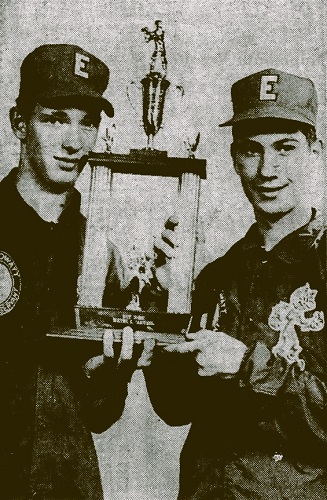 Richard ‘Rick’ Konik, a 6-foot-1 18-year-old, chosen six slots later, is perhaps, the most intriguing of Michigan’s first-round picks.
Richard ‘Rick’ Konik, a 6-foot-1 18-year-old, chosen six slots later, is perhaps, the most intriguing of Michigan’s first-round picks.
A pitcher and all-purpose player, Konik was playing for American Legion Thomas A. Edison Post No. 187 when he impressively became the first to earn the Michigan Legion’s Hazen ‘Ki-Ki’ Cuyler plaque in successive years – 1964 and 1965.
“Cuyler came out of Harrisville, 21 miles south of Alpena, to play 18 seasons in the National League. He was elected to Baseball’s Hall of Fame in 1968,” wrote Hal Schram of the Detroit Free Press, recalling the player and the origins of the award first presented in 1929.
“For the past 45 years, the walnut-based bronze plaque has been awarded each season to the American Legion player judged the most valuable to his team in the annual state championships.”
Future MLB players Mike Tresh (1930), Hal Newhouser (1937), and Milt Pappas (1956), all from Detroit, Neil Berry (1939) from Kalamazoo, Merv Rettenmund (1961) from Flint, and Dick Lange (1967) from Midland were all winners of the award.
The 1964 Edison Post team won the American Legion state tournament, then advanced to the semifinals of the Legion’s Junior World Series played in Little Rock, Ark., before being defeated by Charlotte, N.C., Post 9. The Edison boys repeated as Michigan’s Legion champs in 1965, and advanced to the Regional finals before elimination by Arlington Heights, Ill., in 11 innings. Konik was named MVP of that Regional tournament.
From his sophomore year, Konik’s star shone on the basketball court and baseball diamond at Detroit St. Andrew.
“(I)t’s a rare year when the Flyers aren’t led by a boy who could be even a bigger star at a larger high school,” said the Free Press in May of 1966. “Rick Konik is the top Flyer this year. An (All West, Second Division) All-Catholic basketball player, Konik is drawing even more attention as a pitcher. … He scored the winning run and pitched a no-hitter Thursday to give St. Andrew a 2-0 victory over Our Lady of Sorrows. It was his fifth straight shutout. Konik struck out 15 batters in the seven inning game.”
In June 1966, Konik was picked by the Detroit Tigers in the opening round of the Major League draft at No. 14.
“… Konik of St. Andrew High has been called the best local player wooed by the Tigers since they signed Bill Freehan off the University of Michigan campus,” noted the Free Press following the draft.
According to the Washington, D.C., Evening Star, “the Tigers went as high as $20,000” in their attempt to sign Konik following the draft in ‘66, but Konik rejected the offer.
In January 1967, Konik was a student at Schoolcraft College, when he was drafted for the second time, when the Kansas City Athletics selected the left-handed-hitting infielder in the first round of the Secondary draft. Once again, he couldn’t come to terms and went unsigned.
Konik was drafted yet again, this time by the Washington Senators in the fifth round of the Special Phase draft, in June 1967. Still, they could not come to terms.
In the summers of 1966 and 1967, Konik could be found playing amateur ball in the Free Press Baseball League with A&B Brokers, then was picked up by Detroit Harper Sports for the ‘67 National Baseball Congress (NBC) tournament. Playing first and hitting .500, he was one of 16 players selected to the NBC all-star squad named by the tournament committee in August.
He then enrolled at Eastern Michigan University, where he earned varsity baseball letters in 1968 and 1970. Under head coach Ron Oestrike, the Hurons posted a 41-11 record in 1970, emerging from the District 23 National Association of Intercollegiate Athletics playoffs to advance to the NAIA National Tournament in Phoenix, Ariz. In the championship game, EMU won five straight in double-elimination play, downing Northeast Louisiana State College, 1-0, to win the 14th Annual NAIA College World Series.
While the numbers may be greater thanks to today’s analytic-driven league, a 2012 report by Mike Rosenbaum for Bleacher Report stated, “Only 66 percent of first-round draft picks play in the major leagues.” According to the online database Baseball-Reference, Konik never played professionally.
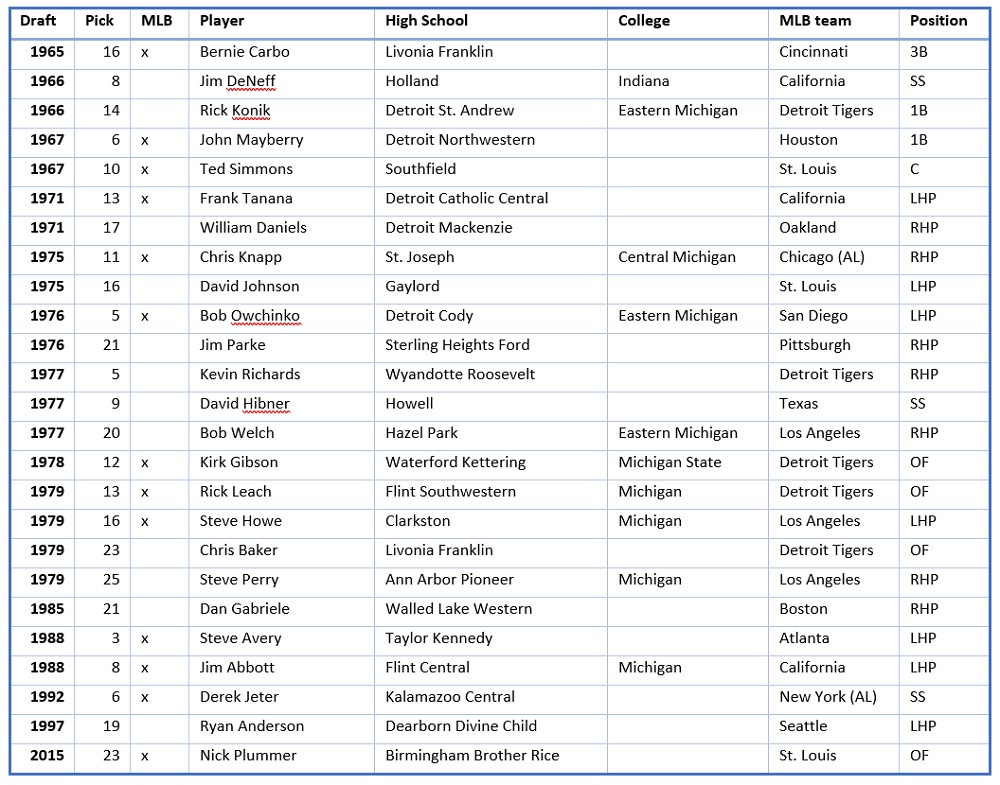
Big Leaguers
The 1967 draft included a pair of three-sport stars picked in the first round. Detroit Northwestern’s big first baseman, John Mayberry, was taken at No. 6 by Houston, followed by Southfield catcher Ted Simmons by St. Louis at No. 10. An All-City basketball selection, the 6-foot-3, 214-pound Mayberry signed a tender in May to play at the University of Michigan, but few expected him to see the court in Ann Arbor.
“Every team in the major leagues came to see Mayberry,” said Fred Snowden, his coach at Northwestern, to the Free Press. Mayberry had posted a .487 average with three home runs and batted in 21 runs. As a pitcher, he gave up only one hit across 11 2/3 innings in relief. “Mayberry was simply too good a hitter to use as a pitcher, so I had him play first base to capitalize on his bat in every game,” added Snowden.
The Colts were still in the thick of the prep baseball season at the time of the draft. Northwestern ultimately downed Detroit Denby, 9-2, to win the City League championship in a game played at Tiger Stadium. It was their first city title since 1959. (In that ’59 league championship game, Willie Horton, then a sophomore, and teammate Matt Snorton, a junior, both smacked tape-measure home runs into the stands at the stadium, located at Michigan and Trumbull. Snorton would later play pro football for the Denver Broncos.)
A starter at first base, Mayberry was called in to relieve in the title game, allowing just a single hit in 5 1/3 innings, as well as ripping a single and a 415-foot triple “to the screen in deep right center.”
Simmons had played ball with Konik on the A&B Brokers team in the summer of 1966. A switch hitter, in 1967 he was hitting at a .490 clip across 18 games at Southfield. The Blue Jays had wrapped up their prep season with a 19-2 record when he was selected by St. Louis. Simmons spent 21 seasons in MLB – including 13 with the Cardinals – and was inducted into the National Baseball Hall of Fame in Cooperstown, N.Y. – along with Jeter – in 2020.
Like his father Frank Richard, who had starred at Detroit St. Andrew in the early 1950s, Frank Daryl Tanana excelled in basketball and baseball. The 6-foot-2 left-handed pitcher had posted a 23-1 mark entering his senior year at Detroit Catholic Central. That past summer he pitched the Larco’s Inn team to the National Amateur Baseball Federation Senior Division championship, played in Cincinnati.
As a high school senior, he had upped his prep mark to 32-1, boasting a sparkling 0.30 ERA, with an average of two strikeouts per inning.
“Tanana started on the mound for Catholic Central,” in a 4-0 loss to Holy Redeemer in the Catholic League First Division baseball championship, played at Tiger Stadium at the beginning of June, “but shifted to first base with a sore arm after pitching hitless ball and striking out eight in four innings.”
The issue was enough for the Tigers – holding the No. 11 pick– to pass over the hometown southpaw in the 1971 MLB draft a week later.
Instead, Tanana was chosen by California. He debuted in the majors in 1973 and spent eight years with the Angels, posting a 102-78 record with a 3.08 ERA during the span. In 1974 – his first full season in the league – he was the team’s No. 2 starter behind Nolan Ryan. He spent 21 years in the majors – including eight in Detroit from 1985 to 1992 – before hanging up the cleats following the 1993 season.
Others from the list of Michigan first-rounders who reached MLB include Chris Knapp from St. Joseph (selected at No. 11) in 1975, Detroit Cody’s Bob Owchinko (5) in 1976, and Waterford Kettering’s Kirk Gibson (12) in 1978.
Rick Leach (13) from Flint Southwestern and Steve Howe (16) from Clarkston advanced to the Big Leagues out of the 1979 draft. Four Michigan players were selected in the opening round that year– the most ever in a single draft.
Steve Avery from Taylor Kennedy at No. 3 – the highest selection among the 25 – and Jim Abbott from Flint Central at No. 8 were both picked in 1988.
Jeter was the sixth pick in 1992, while Plummer was the 23rd player selected in 2015.
The 2022 MLB draft kicks off July 17. MLB.com currently projects Orchard Lake St. Mary's pitcher Brock Porter as the 13th-best prospect eligible for selection.
 Ron Pesch has taken an active role in researching the history of MHSAA events since 1985 and began writing for MHSAA Finals programs in 1986, adding additional features and "flashbacks" in 1992. He inherited the title of MHSAA historian from the late Dick Kishpaugh following the 1993-94 school year, and resides in Muskegon. Contact him at [email protected] with ideas for historical articles.
Ron Pesch has taken an active role in researching the history of MHSAA events since 1985 and began writing for MHSAA Finals programs in 1986, adding additional features and "flashbacks" in 1992. He inherited the title of MHSAA historian from the late Dick Kishpaugh following the 1993-94 school year, and resides in Muskegon. Contact him at [email protected] with ideas for historical articles.
PHOTOS (Top) Clockwise from left: Detroit Northwestern’s John Mayberry, Northwestern’s Willie Horton (a three-year player who, as noted in his senior high school yearbook, “During this entire time in all the league games, he never struck out at bat.”), Livonia Franklin’s Bernie Carbo, and the 1971 Detroit Catholic Central team with Frank Tanana standing second from right. (Middle) Bob Sobditch, left, and Rick Konik, American Legion Edison Post teammates. (Photos collected by Ron Pesch.)
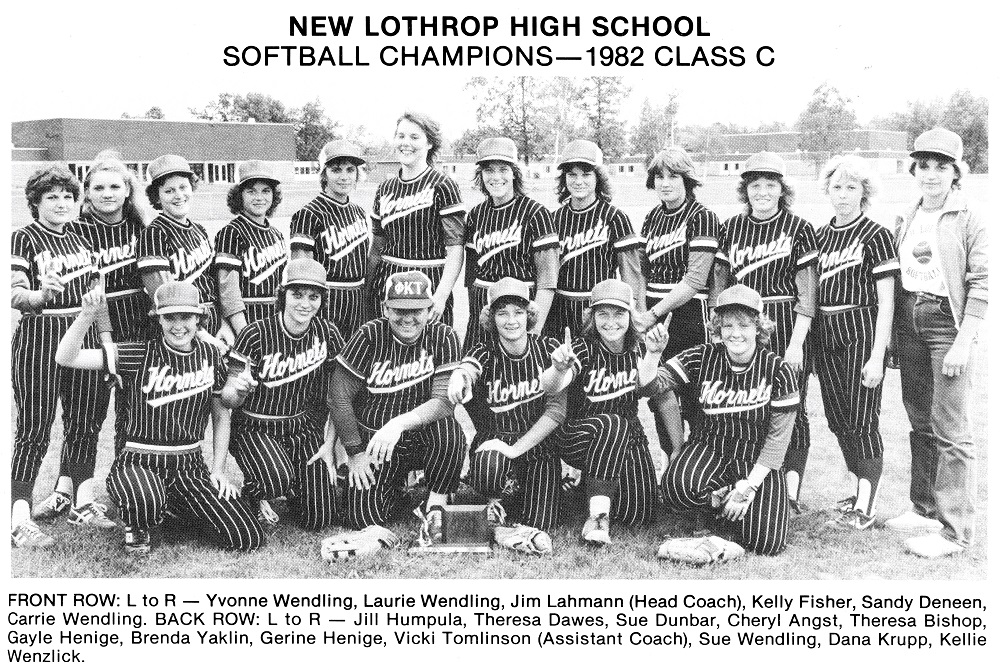
Flashback 1982: Diamond Finals Dominated by 1-Run Title Deciders
By
Ron Pesch
MHSAA historian
June 6, 2022
Heavy downpours earlier in the week, combined with all-night rain on Friday, meant the title games in both baseball and softball were postponed from Saturday, June 19 to the following Monday.
BASEBALL
Those baseball fans making the trip to Central Michigan University’s Alumni Field for the 1982 MHSAA Baseball Finals saw five of the Detroit Free Press’ 11-member Dream team – Rick Leppien of Midland, Bill Hanis from Plymouth Canton, Paul Ouillette from Bay City Handy, Frank Kendall of Mesick and Ron Fillmore from Sanford Meridian (a rare all-stater in three sports).
Runner-up in Class D in 1981, Mesick brought home a state title in ’82, posting a 30-0-1 record, capped by a thrilling – and for some, controversial – 3-2 win over Colon before an opening game crowd of 500.
Colon grabbed a 2-1 advantage in the third inning and had multiple opportunities to up its lead, loading the bases in both the fourth and again in the top of the sixth innings. But the Magi were unable to capitalize. In the bottom of the sixth with one out, Mesick’s Monty Geiger ripped an opposite-field double within inches of the rightfield foul line, scoring Chuck Hockey to knot the game at 2-2, setting the stage for a thrilling finish.
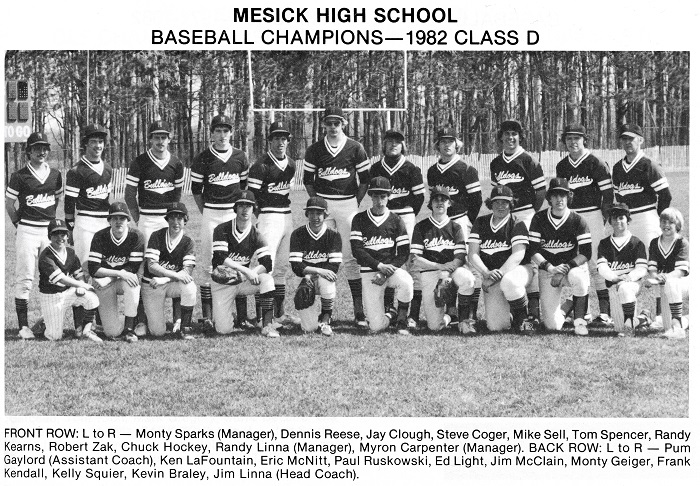 In the seventh, with Mesick runners at second and third and nobody out, Colon coach Mike Sowles ordered an intentional walk to Bulldogs star Frank Kendall. With the bases loaded, a grounder to short was tossed to home plate for the inning’s first out. Another near-identical shot, again to the shortstop, followed. The throw to the plate was accurate and beat the sliding runner, Ken LeFountain. However, the umpire ruled the catcher had been pulled off the plate by the throw, allowing Mesick to score the game winner.
In the seventh, with Mesick runners at second and third and nobody out, Colon coach Mike Sowles ordered an intentional walk to Bulldogs star Frank Kendall. With the bases loaded, a grounder to short was tossed to home plate for the inning’s first out. Another near-identical shot, again to the shortstop, followed. The throw to the plate was accurate and beat the sliding runner, Ken LeFountain. However, the umpire ruled the catcher had been pulled off the plate by the throw, allowing Mesick to score the game winner.
“Our clutch hitting didn’t come through for the first time in a long time,” said Sowles to the Battle Creek Enquirer. His team had stranded 13 runners on the morning. “We just didn’t get the key hits to put them away.”
"Most observers in the press box located directly behind home plate, thought the umpire was right,” stated Steve Morse, staff writer at the Enquirer, who had covered the game.
While Sowles disagreed with the game-ending call, he added, “You’ve got to give credit to Mesick. They pitched out of those jams time and time again.”
Also named all-state in football and basketball, Sanford Meridian’s Ron Fillmore doubled off the centerfield fence, then scored what proved to be the winning run in the fifth inning following a two-out single by catcher Brian Garner as the Mustangs downed Buchanan 6-4 to earn the Class C baseball crown. It was the second consecutive runner-up finish for the Bucks, who finished the year at 25-6.
Beaten only once, at a tournament during the regular season by eventual Class A champion Midland, Sanford Meridian (29-1) banged out 13 hits and opened the scoring in the top of the first when Dave Ehlert scored on a double steal. The Mustangs then added runs in the second, and a pair in the third inning, for a 4-1 lead.
Buchanan knotted the game in the fourth inning.
Fillmore, who was headed back to Central Michigan University in the fall on a football scholarship, tripled, scored twice, and added an RBI on the day. Garner drove in three runs on a double and a pair of singles, while Jim Bailey and Kirk Shauger also added two singles. The Mustangs had added an insurance run in the sixth following a Dennis Ladlow sacrifice fly.
“Fillmore concluded an outstanding athletic career at Sanford-Meridian with his performance in the title contest,” wrote Jack Walkden in the St. Joseph Herald-Palladium. “Three times he bailed starter Dave Walter (12-0) out of tight jams. And the senior righthander closed out the game with a flourish striking out Buchanan’s 1-2-3 batters. He worked 2 2/3 innings in all, yielding no runs, no hits, striking out five, and walking just two.”
“Sanford-Meridian got some other good news Monday,” added Walkden. “The baseball program had been dropped for 1983 as part of budget cuts at the school.
“‘But it’s about 80 percent sure that it will be reinstated through outside funding,’ Sanford-Meridian Athletic Director Steve Digsby said.”
Bob Podschline drove home the tying run with a two-run double in the Class B contest, scored the winning run on a Carl Novick two-run double in the third inning, then racked up 10 strikeouts as Southgate Aquinas topped Bay City Handy, 6-2. The Raiders southpaw allowed just two hits across six innings. Novak added a fifth-inning home run, and Gary Lizanich tossed a hitless seventh to seal the win. Aquinas ended the season with a 22-10 mark, while Handy closed out the year 30-9.
In the day’s final contest, Midland’s Chemics downed Plymouth Canton, 5-4, in Class A. Rick Leppien smacked a 385-foot two-run homer over the left-centerfield fence in the top of the second inning to open the scoring. It was his eighth round-tripper of the year. He scored again on a double steal to up the score to 3-0 in the fourth.
“The Chemics increased their lead to 5-0 with two more runs in the top of the fifth,” stated Don Winger in the Midland Daily News. “Bryan Kuehne doubled, moved to third on a ground out by Chris Carter, and scored when (Canton) shortstop Don Dombey threw wild to first on Mark Sayad’s grounder. Sayad raced all the way to third on the play and pitcher (Greg) Money promptly doubled him home.”
Victory, however, would not come easy.
Leppien, the ace of the Midland pitching staff with a 16-1 record, was limited to a relief role in the championship contest because of a “30 outs rule in effect for the semifinal and final games.” Hence, Midland coach Frank Altimore was forced into juggling pitching duties across four members of the staff.
A series of walks, a passed ball, and a timely single – Canton’s lone hit on the day – cut the margin to 5-3 in the fifth inning. Additional issues in the sixth led to another run, setting the stage for an exciting finish.
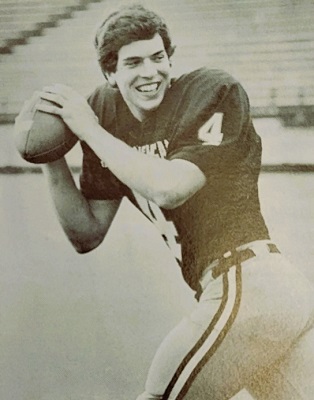 In the bottom of the seventh, Altimore moved pitchers in and out like chess pieces. The Chiefs had the winning run at third base when Money returned to the mound for the fourth time, and “blew a 3-2 pitch” past Canton’s batter to end the game for the final out.
In the bottom of the seventh, Altimore moved pitchers in and out like chess pieces. The Chiefs had the winning run at third base when Money returned to the mound for the fourth time, and “blew a 3-2 pitch” past Canton’s batter to end the game for the final out.
“It was dark, and I told them to just come in with heat. They did, and we won. It was a great ballgame,” said Altimore.
Moments later, “a heavy downpour inundated the playing field,” concluded Winger. “But, by that time the Chemics were celebrating their second state title in 10 years, and they were oblivious to the raindrops.”
Money, the starter, was credited with both the win and the save for Midland, which finished with a 35-5 mark. Canton ended the season at 25-5.
“They were on a vision quest,” their coach would recall in 2007 when the team was honored with induction into the Midland County Sports Hall of Fame. “We had an incredibly talented team in 1981, senior-loaded. They went to the regional finals, where they got beat by a very poor team from Jackson with a great pitcher.”
In total, over 3,100 attended Monday’s baseball games.
SOFTBALL
Three one-run games kept softball fans on the edge of their seats at Lansing’s Ranney Park.
Paula DeFord and Jean Sullivan each drove in three runs as Ann Arbor Gabriel Richard rolled over Gaylord St. Mary, 9-2, for the Class D title. Senior Ann O’Sullivan held St. Mary to just two hits in the day’s opening game. Rain also had pushed the Softball Finals to Monday.
The Irish, focused on aggressive baserunning, stole 10 bases and took advantage of six errors by the young Gaylord squad. Up 2-0 after the first, and 4-2 after three innings, Gabriel Richard pushed across four more runs in the fourth. The Irish ended the campaign with a 30-6 mark, with O’Sullivan finishing her senior year with 16 wins against four defeats.
“New Lothrop’s first batter of the game, Kelly Fisher, crossed the plate with the game’s only score,” stated Bill Khan of the Flint Journal in his article covering the Hornets’ 1-0 win over Pontiac Catholic in the Class C Final. According to Khan, the “lone run couldn’t have been planned much better.
“Fisher led off the Hornets’ half of the first inning with a walk, then proceeded to swipe her 71st base of the season.”
The thefts marked the top season total recorded in Michigan, as well as the nation, at the time.
Fisher advanced to third on a groundout. A squeeze that went back to the mound initially held her at third, but the toss by the pitcher to first for the out opened an opportunity.
“… Fisher came streaking down the line and made a headfirst slide into home,” just under the tag of the relay to the plate, scoring the game’s only run.
Pontiac Catholic junior Vicki Morrow, who would later earn the Big Ten Softball Player of the Year honor at the University of Michigan in 1987 and was later selected to the Big Ten All-Decade Team, struck out five and allowed only four hits, while New Lothrop pitcher Sandy Deneen limited Pontiac’s offense to just five scattered hits and two walks across seven innings. New Lothrop ended the year with a 29-4 record, while the Titans finished at 30-3.
In Class B, Chelsea topped West Branch Ogemaw Heights, 3-2 in 13 innings. Senior Amy Unterbrink allowed just four hits on the day. Lisa Beeman scored the game winner following a single by Amy Hume.
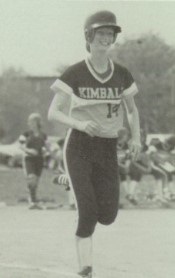 Ogemaw Heights held a 2-0 lead entering the seventh, but a pair of runs in the bottom of the inning by the Bulldogs pushed the game to extra innings. It was the third straight “cliffhanger” for Chelsea, which ended the year with an impressive 33-2 record – tops in school history.
Ogemaw Heights held a 2-0 lead entering the seventh, but a pair of runs in the bottom of the inning by the Bulldogs pushed the game to extra innings. It was the third straight “cliffhanger” for Chelsea, which ended the year with an impressive 33-2 record – tops in school history.
“In the regional final, they scored four runs with two outs in the seventh inning to trip Dearborn Divine Child, 4-2,” according to Rob Allstetter of the Ann Arbor News, “and they needed an Unterbrink double in the bottom of the eighth inning to turn back Richmond in the semifinals, 4-3.”
Royal Oak Kimball topped Grandville 1-0 in a Class A showdown featuring two of the state’s top pitchers, Kimball senior Julie Bishop and Grandville junior Kathy VanDerMolen.
A leadoff single in the seventh was the only hit allowed by Bishop, who upped her career mark to 46-5 with the win.
Kimball’s Lisa Bean, who had walked earlier in the inning, scored the game’s only run in the third when Mary Pike smashed a two-out double over the left fielder’s head. It was one of only two hits allowed by VanDerMolen.
Bean, Pike, and VanDerMolen, Chelsea’s Unterbrink, the Ogemaw Heights battery of pitcher Pam Czach and catcher Sue Pauley, Morrow and Pontiac Catholic teammates Mary Hashinger and Bridget Syron, Gabriel Richard’s O’Sullivan, her catcher Martha Rogers, and infielder Alicia Seegert, as well as Gaylord St. Mary junior Kristin Fosdick all were among postseason all-state first-team selections named by the Michigan High School Softball Coaches Association in mid-July.
 Ron Pesch has taken an active role in researching the history of MHSAA events since 1985 and began writing for MHSAA Finals programs in 1986, adding additional features and "flashbacks" in 1992. He inherited the title of MHSAA historian from the late Dick Kishpaugh following the 1993-94 school year, and resides in Muskegon. Contact him at [email protected] with ideas for historical articles.
Ron Pesch has taken an active role in researching the history of MHSAA events since 1985 and began writing for MHSAA Finals programs in 1986, adding additional features and "flashbacks" in 1992. He inherited the title of MHSAA historian from the late Dick Kishpaugh following the 1993-94 school year, and resides in Muskegon. Contact him at [email protected] with ideas for historical articles.
PHOTOS (Top) New Lothrop’s softball team celebrated the 1982 Class C championship with a 1-0 win over Pontiac Catholic. (2) Mesick won the Class D baseball title that spring. (3) Sanford Meridian’s Ron Fillmore would go on to play football at Central Michigan. (4) Kimball’s Lisa Bean would score the only run of the 1982 Class A Final. (Photos gathered by Ron Pesch. CMU football photo courtesy of the CMU Athletics Organizational Records.)

